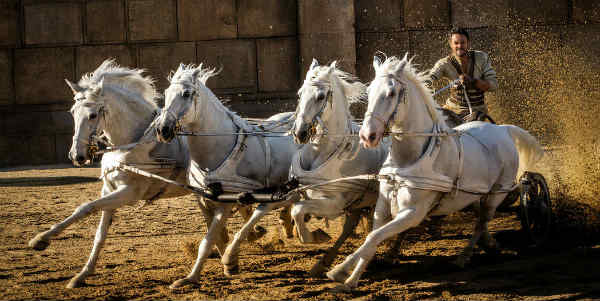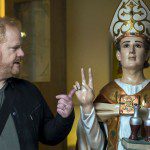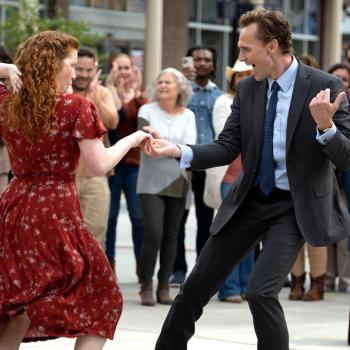 If the opening weekend box-office take is any indication, “Ben-Hur” is been there, didn’t go this time.
If the opening weekend box-office take is any indication, “Ben-Hur” is been there, didn’t go this time.
A lot of Christian leaders urged the faithful to go see “Ben-Hur,” giving it good reviews and thumbs-up for its message. I joined in, offering praise where I felt it was deserved — for the sea-battle and chariot-race scenes, which were done well — and reminding everyone that each Christian-friendly movie that flops convinces Hollywood not to do more of them (or worse yet, to hand off our stories to atheists and secularists who don’t respect the source material).
I’m never doing that again in this blog. The movie’s either good or it’s not. The only thing worse for our cause than a good Christian-friendly movie that flops is a bad one that flops — and probably deserved to. I’m sure there are those who loved “Ben-Hur,” but there’s not nearly enough of them.
From USA Today:
Paramount and MGM’s saga directed by Timur Bekmambetov crashed to a $11.35 million opening weekend, barely finishing fifth, according to studio estimates. The wreck was compounded by an estimated production budget of $100 million.
Even with producers Mark Burnett and Roma Downey (The Bible) and a sizable role for Jesus, Ben-Hur couldn’t attract faith-driven moviegoers to support the retelling of the 1959 classic, which won 11 Academy Awards, including best picture.
“This is the epic fail of the summer,” says Jeff Bock, senior box-office analyst for Exhibitor Relations. “This was pushed as a straight-up action film. They courted the Christian demographic too late.
“And don’t remake a film that won best picture,” Bock adds. “They still teach Ben-Hur in film school. Hopefully, this is a lesson for Hollywood.”
Let’s be honest, “Ben-Hur” probably failed because it’s not especially good overall, and it’s definitely not an improvement on the 1959 version starring Charlton Heston, which was a box-office success and earned several Academy Awards, including best actor (for Heston), best director (for William Wyler) and best picture. Many Christian moviegoers are pretty savvy and checked out the early reviews, which were not encouraging (including this thoughtful one from an actual Christian critic at the Los Angeles Times, of all places).
In losing over an hour of screen time, the story got truncated (I’m not going to rehash the plot — click here to go to Bishop Barron’s review for that, including the ending). A lot depended on Morgan Freeman , whose horse-racing sheikh character had to marshal the transition of disgraced Jewish prince Judah Ben-Hur from broken-down galley slave to crusading charioteer.
I’ve seen Freeman do some great acting, but here, he was just being Morgan Freeman in a big gray wig. I didn’t believe he was a sheikh of any sort. I just believed he was Morgan Freeman.
It didn’t help that the leads weren’t up to the task. Toby Kebbell was serviceable as Messala, but Jack Huston — who was very good as a tortured World War I vet in “Boardwalk Empire” — lacked the physicality and charisma to pull off Judah Ben-Hur. Just look back at how easily Charlton Heston wears his masculinity. He’s powerful and strong without being brutish. That’s the mark of a mature man. In today’s movie biz, we have a lot of adult boys who are pretty enough and relatively nonthreatening — and an odd sprinkling of musclebound tough guys — but a deep lack of actual men (and the few we have under the age of 50 seem to come from Australia). That may be a function of who chooses to be an actor these days, how they’re trained, the feminization of the culture — I don’t know.
I could believe Kebbell and Huston as a lot of things, but I didn’t buy them in these parts, which required a swagger and physical presence that they just didn’t project.
Also, I thought the female characters were stronger in the 1959 movie — more dignified and self-possessed. There’s an irony.
The first half of “Ben-Hur” dragged endlessly with limp soap-opera back and forth, then suddenly — without the luxury of the 1959 film’s long character progression for Ben-Hur — we’re in the chariot race. Even with all of today’s modern technology, it was good, but it wasn’t any better than the 1959 version. But by then, I was so bored it hardly made a difference.
Oh, and Christ — played by a hunky Brazilian this time — popped up every now and then to deliver nuggets of wisdom. But Ben-Hur’s tears at the Crucifixion felt gratuitous. It felt like he was crying because we expect people to cry at the Crucifixion, not because we were shown that he had a real conversion (which did happen with Heston’s Ben-Hur).
Then, worst of all, in defiance of the original story and the 1959 movie, an abrupt, unearned, happy-clappy ending was slapped on, with Messala hopping along on his one leg to be welcomed back into the arms of his loving adopted family.
I wanted to gouge my eyes out.
Why was this done? I suspect it was for the Evangelical audience. I can’t imagine Catholics demanding a saccharine ending to anything. We’re as much Crucifixion people as Resurrection people, which can’t always be said for our separated brethren.
As for not targeting the Christian audience early enough, I disagree. One thing executive producers Mark Burnett and Roma Downey know how to do is market to the Christian audience, especially Evangelicals. They must have the most amazing mailing list in Christendom. I went to a screening and a press day at Paramount Studios back in June, and all stops were pulled out to reach out to faith leaders, from Catholics like EWTN’s Raymond Arroyo and Sister Rose Pacatte, to big-name Evangelicals like Rick Warren.
Everyone did their part — trumpeting this film up and down the Internet, over the airwaves and from non-Catholic pulpits (if anyone did do a homily about “Ben-Hur,” they need to rethink that). I can’t imagine what more Burnett and Downey could have done to flog this film.
If only they had a better movie to promote.
Why, after all this time, does 2004’s “The Passion of the Christ” remain as the biggest box-office success of all recent Christian-themed films? We can start with, it was really, really good. Mel Gibson may not be the most stable individual in the world, and his Catholicism has a few dents and dings, but the man can direct a movie. Doing it in the original languages took it out of the dreadful sword-and-sandals trend of British accents (working-class ones for Roman soldiers; posh ones for Pontius Pilate, etc.) and gave it verisimilitude.
Jim Caviezel did a magnificent job as Jesus, sacrificing his body and his health to make it feel real.
From a piece I did earlier this year:
Wielding not a delicate artist’s brush but a sledgehammer, he crashed through any pious distance we ever had from the Cross of Christ and laid it out in meticulous detail — every lash, every bruise, every moment of agony. It’s hard to watch, and harder to forget.
I confess — I saw “The Passion of the Christ” once, in a movie theater, surrounded by wailing, sobbing people. I’ve never seen it again. But its power, even today, remains undiminished, and I would recommend it in a heartbeat to any serious Christian, or anyone who wants to enter deeply into the reality of Christ’s sacrifice.
After the movie ended, as I was standing up, restoring the circulation to my lower body (it’s a long movie), I watched a couple of young men come down the stairs. They were hip, cool L.A. guys, with chains hanging from their pockets, bandannas tied around their heads, tattoos and baggy jeans — and they both looked like they’d been hit by a bus. I caught the eye of one of them, just as he was reaching up to rub his nose. His red-rimmed eyes met mine, and he gave a a little smile and small shrug, as if to say, “Yeah, it got me.”
Maybe it’s because Gibson is neither a secular nor Evangelical filmmaker. He’s a Catholic, with all the color, drama, mystery and power that the Faith contains. I recently saw an early screening of his new faith-influenced World War II drama “Hacksaw Ridge.” More on that later (and there’s an embargo), but I can say that, once again, Gibson is fearless, brutal and delicate where appropriate, never backing off from the hard moments.
He paints in bold, medieval colors, not washed-out contemporary pastels.
The Church of Michelangelo and Dante and Beethoven and Chesterton deserves better than “Ben-Hur” and should demand nothing less.
But, all this being said, if faithful Catholics passed on “Ben-Hur” and instead shelled out money for soulless dreck like “Suicide Squad” and “Sausage Party,” then they’ve got bigger spiritual problems than any money can address.
Image: Courtesy Paramount/MGM
Don’t miss a thing: head over to my other home at CatholicVote and like my Facebook page; also like the Patheos Catholic FB page to see what my colleagues have to say.













